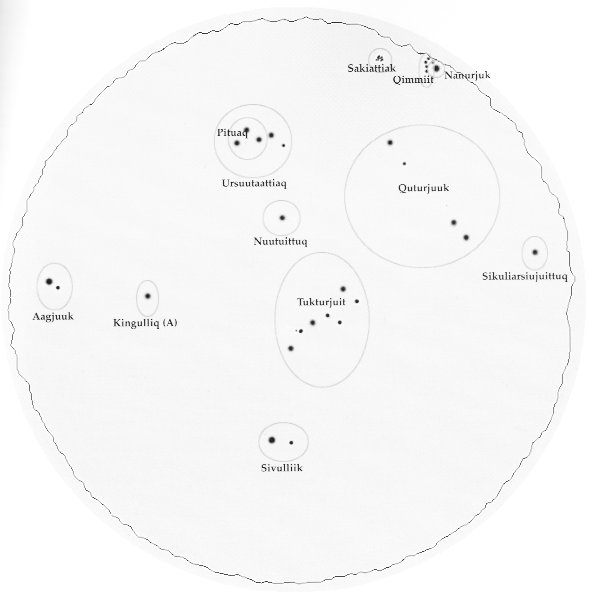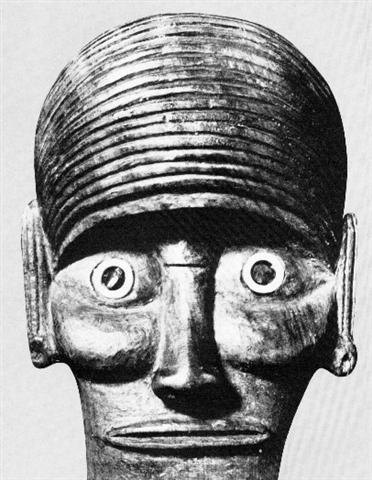|
ADDENDA
222.9 Once again, the 'agruks' were reappearing at the horizon in late December it was said:
... Some people lived down at the coast, including a grandmother and her grandson. The grandson always took his grandmother's potty out, every evening and every morning. One time in the evening he didn't come back for a long time, so the grandmother went out to look for him. Towards morning, when the agruks {the two beams of light cast by the sun when it first reappears above the horizon in late December} came out, the grandmother looked for her grandson ... In other dialects they were named e.g. Aagjuuk, and below we can see their location at the apex of a triangle with Cassiopeia and Ursa Major at the other corners. Thus they corresponded to the pair of brightest stars in the Aquila constellation, viz. Altair and Tarazed:
The precession had apparently moved them from late December to the middle of January. ... Most published descriptions of Aagjuuk tend to leave the impression that it suddenly appears on cue as if out of nowhere... This definition is somewhat misleading because throughout the autumn and winter months at latitudes above the Arctic Circle Aagjuuk's principal star, Altair, is one of the brightest and most visible stars in the south and western sectors of the sky. But so completely is Aagjuuk identified with mid-December and the winter solstice that one Igloolik elder, invited to point to the constellation in early November, firmly replied that we would not see it until around Christmas, and this in spite of the fact that Altair was at the time in full view to the southwest ... The figure in the center of Ca1-6 is holding things together in contrast to the disintegration described in Cb1-6. The constellation of the Eagle was by the Inuit peoples placed in December, the place for the winter solstice which marked where a new Sun year (= day so far up close to the north pole) was due to be born. But from the table above we can guess the creator of the C text might have had the September equinox in mind for Ca1-6, because at the equinox in March the Sky was pushed up high in order to let in air and light to enable the recreation of life. Therefore the upper and lower 'clam shells' had to be held tight together in September. ... A very detailed myth comes from the island of Nauru. In the beginning there was nothing but the sea, and above soared the Old-Spider. One day the Old-Spider found a giant clam, took it up, and tried to find if this object had any opening, but could find none. She tapped on it, and as it sounded hollow, she decided it was empty. By repeating a charm, she opened the two shells and slipped inside. She could see nothing, because the sun and the moon did not then exist; and then, she could not stand up because there was not enough room in the shellfish. Constantly hunting about she at last found a snail. To endow it with power she placed it under her arm, lay down and slept for three days. Then she let it free, and still hunting about she found another snail bigger than the first one, and treated it in the same way. Then she said to the first snail: 'Can you open this room a little, so that we can sit down?' The snail said it could, and opened the shell a little. Old-Spider then took the snail, placed it in the west of the shell, and made it into the moon. Then there was a little light, which allowed Old-Spider to see a big worm. At her request he opened the shell a little wider, and from the body of the worm flowed a salted sweat which collected in the lower half-shell and became the sea. Then he raised the upper half-shell very high, and it became the sky. Rigi, the worm, exhausted by this great effort, then died. Old-Spider then made the sun from the second snail, and placed it beside the lower half-shell, which became the earth ... 3 + 3 = 6 → 336 (December 2) = 245 (September 2) + 91. ... They were Ranginui, the Sky Father, and Papatuanuku, the Earth Mother, both sealed together in a close embrace. Crushed between the weight of their bodies were their many children, whose oppression deepened. They yearned to be free; they fought their parents and each other to break loose. Tuumatauenga, virile god of war, thrust and shouted; Tangaroa of the oceans whirled and surged; Tawhirirangimaatea howled with many raging winds; Haumiatiketike and Rongomatane, of wild foods and cultivated crops tried their best but were not successful; and Ruamoko, god of earthquakes, yet to be born, struggled in the confinement of his mother's womb. Of them all, Taane Mahuta, the god of the forests, was the most determined; he set his sturdy feet upon his father's chest, and braced his upper back and shoulders against the bosom of his mother. He pushed; and they parted. So the world; as the Maori understand it; came into being ... The winter solstice would be an obvious choice for the absence of the life-giving Sun. But, as if by chance, there was a complete solar eclipse yesterday, in April 8 (99, *19) AD 2024. And as if by design the diameter of the Moon was exactly enough to precisely cover the disc of the Sun. *19 + *6 = *25 (April 14) → 4-14 → *41.4 (Bharani) - once again as if by design. ... needfire ceremonies usually take place near the summer solstice (the Feast of St. John) ... but they occur in several other seasons as well. The summer date of the rite and its accompanying festival have to do, among other things, with fertility, as can can clearly be seen in a variant from the valley of the Moselle preserved for us by Jakob Grimm. Each household in the village was constrained to contribute a shock of straw to the nearby high place, Stromberg, where the males went at evening while the females went to a spring lower down on the slope. A huge wheel was wrapped with this straw. An axle run through the wheel served as the handles for those who were to guide it on its downward plunge. The mayor of a nearby town kindled the straw, for which office he was rewarded with a basketful of cherries. All the men kindled torches and some followed the burning orb as it was released downhill to shouts of joy. The women at the spring echoed these shouts as the wheel rushed by them. Often the fire went out of its own accord before it reached the river, but should the waters of the river extinguish it, an abundant vintage was forecast for that year ... The hakaariki glyph in Da8-3 is obviously not a description of the 'opening of the mouth' but instead rather its opposite, with the figures forming a tight line and standing low (as if submerged in water).
But there were 6 of them:
... Far away, the Mangaians of old (Austral Islands, Polynesia), who kept the precessional clock running instead of switching over to 'signs', claim that only at the evening of the solstitial days can spirits enter heaven, the inhabitants of the northern parts of the island at one solstice, the dwellers in the south at the other ... Considering the fact that the crossroads of ecliptic and Galaxy are crisis-resistant, that is, not concerned with the Precession, the reader may want to know why the Mangaians thought they could go to heaven only on the two solstitial days. Because, in order to 'change trains' comfortably, the constellations that serve as 'gates' to the Milky Way must 'stand' upon the 'earth', meaning that they must rise heliacally either at the equinoxes or at the solstices. The Galaxy is a very broad highway, but even so there must have been some bitter millenia when neither gate was directly available any longer, the one hanging in midair, the other having turned into a submarine entrance ... The dream soul (kuhane) of Hau Maka sleeping in the old homeland began to name the relevant features of the new land with the group of 3 islets outside the southwestern corner of Easter Island, and they were named 'the handsome youths of Te Taanga, who are standing in the water.' [E:6] There might therefore be a correspondence between these 3 youths and the hakaariki type of glyph.
|
.jpg)








